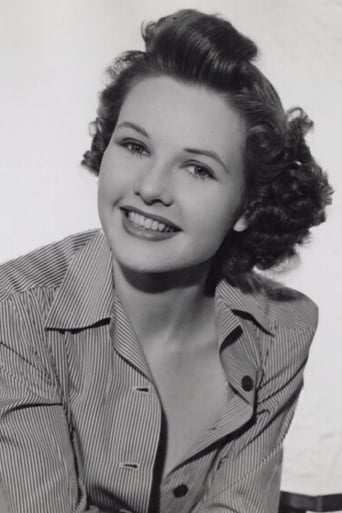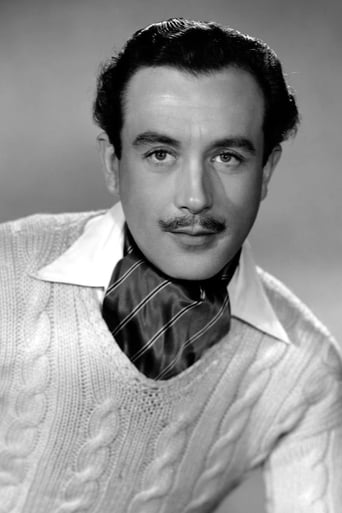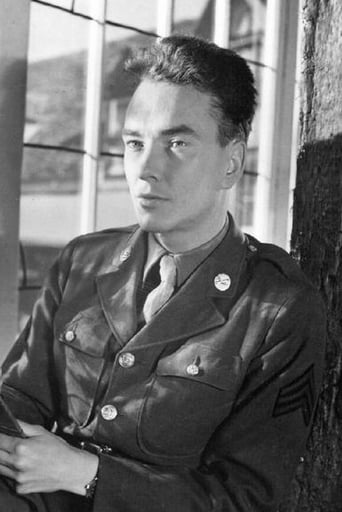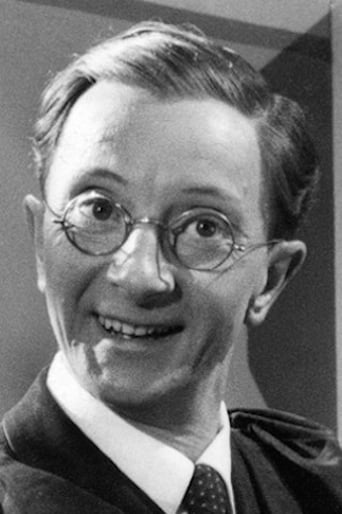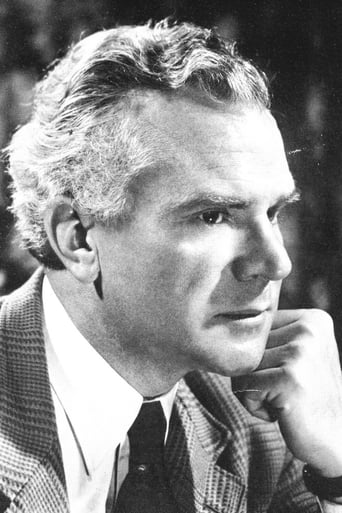ChikPapa
Very disappointed :(
Fluentiama
Perfect cast and a good story
Mjeteconer
Just perfect...
Married Baby
Just intense enough to provide a much-needed diversion, just lightweight enough to make you forget about it soon after it’s over. It’s not exactly “good,” per se, but it does what it sets out to do in terms of putting us on edge, which makes it … successful?
James Hitchcock
Michael Powell was born in Canterbury, and "A Canterbury Tale" can be seen as his love-poem to his native city. The film opens with a quotation from Chaucer's "Canterbury Tales" and a shot of his pilgrims making their way to Canterbury, and the action is set either in the city itself or in the nearby fictitious small town of Chillingbourne (an amalgam of the villages of Chilham, Fordwich, and Wickhambreaux, with the name perhaps owing something to "Sittingbourne"). His three main characters- British Army Sergeant Peter Gibbs, U.S. Army Sergeant Bob Johnson and Alison Smith, a "Land Girl" - arrive by train in Chillingbourne one summer evening and are explicitly compared to modern-day pilgrims. Part of the story concerns the "blessings" they receive after they visit Canterbury.The main problem with the film is that the central story is a silly one. Peter, Bob and Alison learn that somebody in Chillingbourne is pouring glue into the hair of local girls who have been dating soldiers from a nearby camp, and decide to unmask the culprit. We do eventually learn who the "glue man" is, and what his motive is, although this might have come as a surprise to audiences in 1944, and will probably still surprise modern ones. He is motivated neither by jealousy at losing a girlfriend to a soldier (which would probably have been the most common guess in 1944) nor by some bizarre sexual fetish (which would probably be the most common guess today).Powell and Pressburger were concerned to encourage wartime Anglo-American friendship (a theme they also dealt with in a later film, "A Matter of Life and Death"), but the character of Bob does not seem particularly calculated to endear the British public to their transatlantic guests. He is the sort of Yank who greets every minor difference between the British and American ways of life (driving on the left, unarmed policemen, etc.) not only with bafflement but also with a barely-concealed belief that the American way of doing things must inevitably be superior. At times, in fact, The Archers actually seem to be exaggerating Anglo-American differences in order to make a point. Contrary to what we are led to believe here, quite a lot of Americans do indeed drink tea, and no American would express surprise at a settlement as small as Chillingbourne being called a town. (In many parts of the States the word "village" is rarely used and the word "town" is used to describe settlements which in Britain would be considered villages).The character of Bob is played by Sergeant John Sweet, a real-life American GI. He never appeared in another film after this one (although he lived to be 95), and I cannot say that the decision to use an amateur actor really paid off; perhaps Powell and Pressburger had difficulty finding a professional American actor in the England of 1944. When the film was released in America after the war, the Canadian actor Raymond Massey acted as narrator- Esmond Knight narrated the British version- and extra scenes were added with Kim Hunter as Johnson's girlfriend. (Massey and Hunter were chosen because they were due to star in "A Matter of Life and Death").What saves the film from a lower mark is the quality of the cinematography. Powell achieves some striking black and white photography of the city of Canterbury and of the surrounding countryside. An important scene takes place in Canterbury Cathedral, but because of wartime conditions the Cathedral itself was not available for filming; this scene was shot on a set recreated in the studio. Two years before the film was made, the city had been devastated by enemy bombing during the so-called Baedeker raids; according to Nazi propaganda Canterbury had been singled out because the city's Archbishop, William Temple, was an advocate of the bombing of German cities. Powell and Pressburger do not shy away from depicting the devastation caused by the bombing; indeed, they make it a theme of their film.The rural parts of the film are perhaps even more important than the urban ones. The theme is essentially what might be called neo-romantic nationalism, a sense that in the English landscape the past always haunts the present. At the time the film probably seemed to express a timeless vision of an unchanging rural England; Bob, a carpenter in civilian life, finds that he can talk to the local wheelwright without risk of cultural misunderstandings because both Britain and America hold to traditional methods of woodworking. Yet this was an England which already stood on the verge of change. In the forties many farms still relied upon horse-and-cart methods of agriculture, and the local wheelwright would have been a key figure in any village. The mechanisation of agriculture, however, had begun in the twenties and thirties, and even from the vantage-point of 1944 it was probably already predictable that the old methods would not last for very much longer. As things turned out, the horse-and-cart days were largely gone by the sixties."A Canterbury Tale", therefore, attempts to deal with some quite ambitious themes. It is a pity that a better storyline could not have been found to embody them. 6/10 A goof. The character Thomas Colpeper, who is supposed to be very knowledgeable about the local area, mentions "heather" among the flowers which can be found on the Downs near Chillingbourne. A genuinely knowledgeable local man would have realised that heather needs sandy, acidic soils and therefore will not grow on the chalky, alkaline soils of the North Downs.
wrs10
I have just seen this film for the first time in years. It remains to me as interesting as ever it was. Maybe the story is banal but soap operas re-work the themes endlessly for a reason. Apparently critics, on release, panned it and it did poorly at the box office. I guess the lack of an on-screen romance failed to appeal to the ladies and the lack of blood and guts failed to appeal to the gents. Never mind, when the film reached the small screen it passed on down the generations! I suppose the post-war generation was comfortable with letting the children see this one! It also reminded people of what they did for the war effort. Very few reviewers here have commented on the mass takeover of traditional male jobs by females. It was simply a dramatised documentary at that level. (My mother thought that her Land Army work was the only really valuable job that she had done - although it was the poorest paid!) I am puzzled by the assumption by some reviewers of mass lesbianism - almost a million more of Britain's men had been killed in WW1 than women. That left a million women on the shelf, due to arithmetic, not lesbianism. And everyone smoked in those days! A few incongruities stuck out. No references to the food shortages, weird. Would someone really have drunk a whole pint of milk for lunch? "Foyle's War" and "Dad's Army" do not make that mistake. And where were the "Doodlebugs"? Of course, with the outdoor filming taking place in 1943 there would have been none but the lack of reality for the 1944 audience must have jarred. Agriculture was not as backward as shown, Michael Powell would have been referring more to his youthful experiences than to wartime practice. Also forestry during the war was handled on very short term considerations. No shipping space for the usual imports so just about everything was lifted without regards to "sustainability" or even mediocre management. A few lumberjills in the film would have been realistic. Leaving them out was a bit odd. They were not rare.(As an aside for a film released in May 1944 - was the army march through Canterbury a tiny part of the deception plan to deceive the Germans that the Allies intended to land in the Pas de Calais, not Normandy?) Other details stand out for me, such the sign of the bombed out Singer sewing machine shop stating where they had relocated to. When I was growing up I could see the largest Singer sewing machine factory in Europe from our living room window so the sign stood out. That scene also explained the slight disappointment I had with the shopping centre in Canterbury when I visited it for the first time - OK but it could have been anywhere in the country, nothing special about that 1950s rebuild. Canterbury suffered not just from the Baedeker air raids but also from the fact that any German bomber that did not think that it could reach London preferred to dump its load where it would do some damage other than churn up some fields. The cathedral was hard not to spot and there were (are) two important rail lines going through the town and were worth disrupting.It is a pity that the film has not been colourised. It would not make much difference to the indoor scenes but the outdoor scenes would be given a great lift. I did once walk from Dover to Canterbury. Pleasant if unremarkable for most part. Crossing the M20 and going alongside it for half a mile does dilute the magic somewhat but as one approaches Patrixbourne from above, the Cathedral comes into view and appears like an ocean going liner towering above a sea of green. It is easy to understand why a filmmaker would want to make something of it.Also worth noting is the long established pilgrimage from Winchester Cathedral to Canterbury (even medieval Italians have been recorded doing it!) Again, it is easy to understand why a filmmaker would want to play on its themes. Despite there being a "Pilgrim's Way" marked on the Ordnance Survey maps there was no one route - through Rochester Cathedral then along the straight Roman Road was just as popular a route as the "Pilgrim's Way" so it is easy for a filmmaker to contrive of different "ways" into Canterbury.
Robert J. Maxwell
After the first half hour or so I was ready to turn the movie off and get back to my book. The acting and story both seemed patched together out of nothing much.Three people are stranded temporarily in a small English village during wartime, all planning for one or another reason to visit the cathedral in Canterbury, to which the pilgrims of 600 years earlier had traveled for blessing or to do penance. Eric Portman is the equivalent of the mayor. He's a fourth figure who seems to preside over everything. He's a mystical presence who is friendly enough, eager to impart his knowledge of Canterbury and its pilgrims to anyone willing to listen to him, but he keeps coming up with these portentous yet elliptical sayings that seem pregnant with some sort of deeper significance. "A caravan is temporary. All things with wheels are meant to move." It's not as silly as it sounds when taken out of context like this, and Portman does a good job in its delivery.The three travelers who provide the focus for the film are John Sweet, a talkative sergeant in the US Army, who looks goofy, sounds like Red Skelton, and moons over the girl back home who hasn't written him in seven weeks. His adventitious companions are Shiela Sim, a chirpy and no-nonsense young lady who believes her fiancé to have been shot down and killed over Europe; and Dennis Price, younger and more ridden with momentum that you've ever seen him before, a disillusioned sergeant from the big city who gave up a career as an organist. They are drawn together by their status as guests in the little village and by their joint desire to find out who dumped glue into Shiela Sim's hair during the blackout. (They never do find out.) Well -- they bump into each other from time to time, and into other village residents, until they decide to coordinate their efforts to find the miscreant. After the first half hour I took up my book several times but couldn't concentrate on it because I was continually drawn back into the movie.Things happen, little events, that you don't expect to see or hear. I'll give an example of what I mean. Here's Sergeant Sweet, from Oregon, USA -- timber country. He's a figure of some ridicule. He speaks like a hick and smokes a corn cob pipe and says things like, "Say, Pop, is there a hotel in this town?" People make gentle fun of the fact that his sergeant's chevrons are upside down. But then the script gives him a quiet scene in a large carpenter's shop in which he displays dignity, generosity, and a shared knowledge of lumber with the proprietor. As a comic figure, he's a failure. As a more fleshed out character, he succeeds.The same thing happens to a greater or lesser extent with the other characters. All three of them achieve some sort of satisfaction by the end: Sweet finally gets a fist full of letters from his girl friend back home; she'd joined the WAACs and been transferred to Australia. Sims learns her fiancé is alive and in Gibraltar. Price meets the organist at Canterbury Cathedral, rediscovers his calling, and runs through Bach's Toccata and Fugue in D Minor, a thrilling piece, while the camera slides into a long shot of the cathedral's immense nave and its magnificent vaulting. It's a hair-raising image that reminded me of Kenneth Clark's series, "Civilization." There's more to it than meets the eye during that first half hour. There's even some impish humor. During an argument with Eric Portman on the train to Canterbury, Price makes some scoffing remark about, "When that happens, I'll be wearing a halo round my head," and at that moment the trains lurches into the sunshine, the compartment floods with light, and Price's head is backlighted with the glow.If we want to be banal, it's a message movie. It's 1944. The Yanks have invaded England preparatory to invading France on D Day. We must all pull together and hope for the best. And let's not forget that, though England may change, the nation is a monument to itself and its own past, just as the cathedral is. God's in His heaven; all's right with the world -- or will be, just as soon as we can figure out how to operate these danged English phones and reckon the translations from quarters and dollars to shillings and quid.It's a tranquil and good-natured fairy tale, though still a fairy tale. During Chaucer's time the cathedral was used as a dormitory for travelers, pilgrims, and the poor. The Archbishop of Canterbury is the nominal head of the Anglican Church but four Archbishops were murdered. Yet the fact that it's uplifting in its own way adds to its charm, rather than detracts from it. I don't believe that "There's no place like home," either, but I almost choke up when Dorothy clicks the heels of her ruby slippers together at the end of "The Wizard of Oz." What WOULD we do without our myths?
TheLittleSongbird
I love Powell and Pressburger's films, especially Black Narcissus, A Matter of Life and Death, The Red Shoes, The Life and Death of Colonel Blimp and The Thief of Baghdad. A Canterbury Tale is no exception, in fact it is every bit as wonderful as those films. Essentially it is gentle, it is sweet-natured and it is beautiful, but it is also thought-provoking and atmospheric with eerie tone shifts. As to be expected, the production values in this film is absolutely exquisite, as skilled as the photography is, it is the scenery that really delights, while Allan Gray's music is very nice. The script is good on the whole, and the story(a re-think of Chaucer?) may be peculiar on paper but actually it is nothing of the kind. Instead it is well-structured, beautiful and most importantly it impresses as a study of a community resistance to change, and I admit I was moved by this film. The direction is great, and the acting I had little problem with- excepting Dennis Price from Kind Hearts and Coronets and Charles Hawtrey from the Carry on franchise there was nobody I recognised straight away but the actors all played their parts well. The pace is perhaps meditative, but purposefully so to reflect the film's gentle tone. All in all, a lovely, thoughtful film and one of Powell and Pressburger's best. 10/10 Bethany Cox

